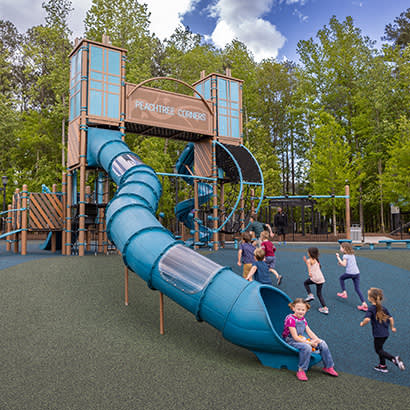
For an enhanced digital experience, read this story in the ezine.
There is perhaps no better refuge for kids from social media and screen time than their local playground. And with today’s bigger, more colorful and more engaging playground equipment, kids are enjoying richer play experiences than ever.
But building the playgrounds that people want isn’t just about picking equipment from a catalog. Communities must consider how they can create fun and unique spaces kids want to come back to while addressing the diverse needs of community members. And, at the end of the day, they’re creating not only better playgrounds, but also better communities.
Here are some of the things that communities are trying to achieve in their playgrounds today.
Spaces That Reflect Their Communities
Communities are creating unique play spaces they can claim as their own and use to showcase their identity and history. For example, Playground Fantastico in Napa, California, redefines community spaces with its contemporary approach to playground design by creating a vibrant and engaging environment to invite imagination and social connection. The walking bridge that connects two play towers at a new playground in Peachtree Corners, Georgia, recreates the pedestrian bridge that recently was built above a highway at the entrance to town.
Play spaces even are helping shape the identities of communities without central gathering spaces. In Shoreview, Minnesota, a destination playground was built on the same campus as a library, community center and other amenities, creating a community-defining town center.
Taking Play to New Heights
Until about a decade ago, playground equipment generally didn’t exceed eight feet. But today, communities are asking for play structures that are 30 feet tall or higher. Skyscraper-like towers and high-rising slides are now signature elements at destination playgrounds. These structures also allow cities that have limited footprints for parks to build up when they can’t build out.
Tall structures can incorporate a variety of features that create more opportunities for kids to play and encounter challenges depending on how much of a risk taker they are. Materials like belting and netting help keep play safe by creating a soft surface for kids to land on if they lose their grip. These structures also provide social spaces with a bird’s-eye view, which can increase playground participation for kids who might prefer socializing over physical play.
Playgrounds Created Through Collaboration
When people work together, they can make play more accessible and even reimagine what play can be. Sometimes this collaboration is as simple as equipment providers helping communities get the most from their budget and footprint — like with preconfigured designs that maximize play activities within a compact space.
In other cases, the collaboration is more intimate. For instance, landscape architects are working with equipment designers and communities to achieve a better marriage of topography and play. This allows communities to weave playgrounds into and around trees, slopes and other environmental features, creating unique play spaces.
Inclusive play advocates also are helping everyone, from playground designers to city leaders, make play more accessible. Together, they’re building playgrounds that can be enjoyed by kids of all abilities. And, they’re closing “play deserts” and making playgrounds more available to historically underserved community members.
Scott Roschi is Creative Director at Landscape Structures, Inc.


